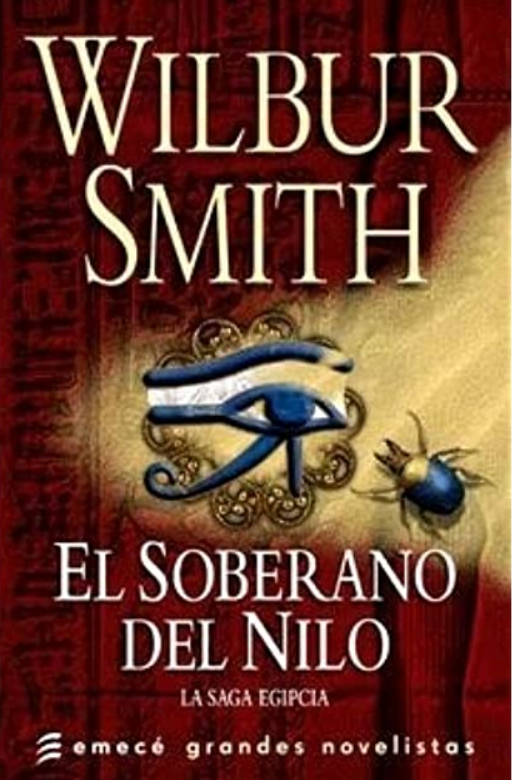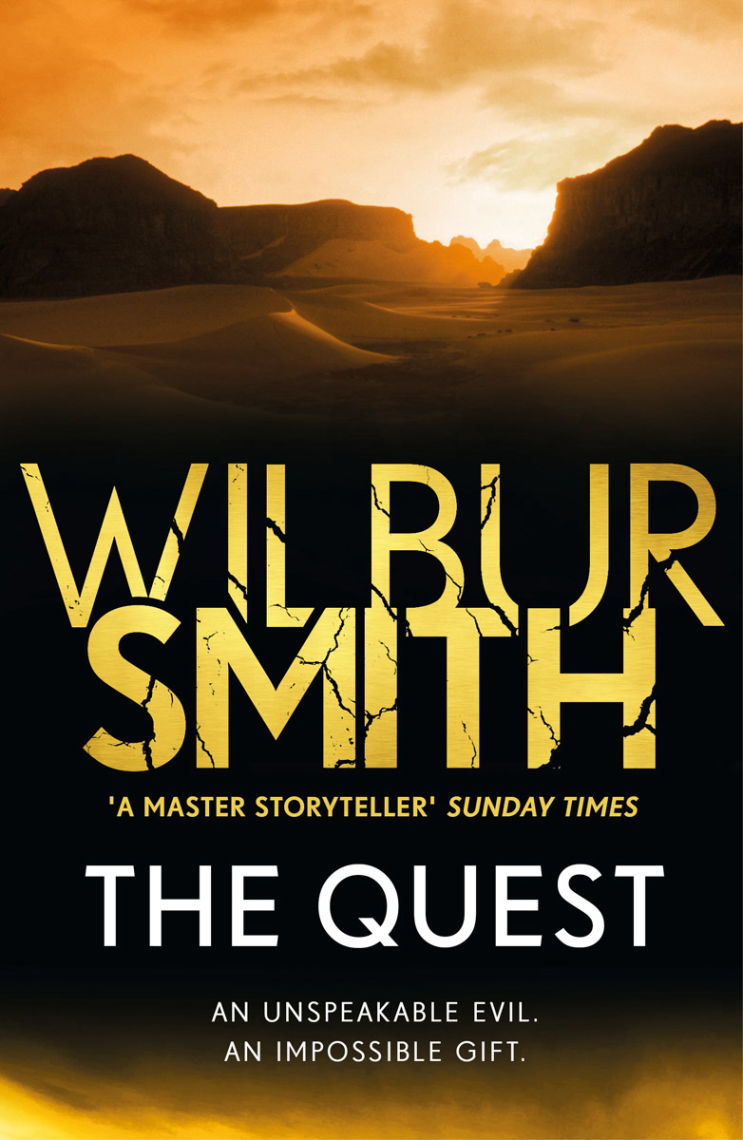
Si hay un escritor identificado en todo el mundo con el continente africano en sus obras literarias ese es sin duda Wilbur Smith nacido en Zambia (ex-Rodesia del Norte).
Ya sea a través de relatos ambientados en los siglos XVI y XVII en el sur de Africa, o a través de thrillers y novelas de suspenso relacionadas con ese ambiente, ha dividido su obra literaria en sagas.
La primera fue la saga Courtney que tiene como epicentro la familia del mismo nombre y es la más extensa de todas (16 volúmenes).
La segunda fue la saga Ballantyne relacionada también con una familia, en este caso de Rodesia del Norte, como eje principal. Consta de 5 volúmenes.
La tercera fue la saga egipcia, llamada también saga de los faraones, es la serie de la que hace parte el libro cuya reseña les comparto hoy: El Soberano del Nilo -es la cuarta obra de la saga en orden de aparición- y consta de seis volúmenes.
La cuarta es la saga Hector Cross, la más breve de todas, y también la más moderna, iniciada en 2011 y terminada en el 2016 con Predator. Consta solo de tres libros.
Algunas de sus obras han sido adaptadas para el cine y la televisión.

If there is a writer identified throughout the world with the African continent in his literary works, it is undoubtedly Wilbur Smith born in Zambia (ex-North Rhodesia).
Whether through stories set in the sixteenth and seventeenth centuries in southern Africa, or through thrillers and suspense novels related to that environment, he has divided his literary work into sagas.
The first was the Courtney saga whose epicenter is the family of the same name and is the most extensive of all (16 volumes).
The second was the Ballantyne saga also related to a family, in this case from Northern Rhodesia, as the main axis. It consists of 5 volumes.
The third was the Egyptian saga, also called the saga of the pharaohs, it is the series of which the book is part whose review I share with you today: The Sovereign of the Nile -it is the fourth work of the saga in order of appearance- and consists of six volumes.
The fourth is the Hector Cross saga, the shortest of all, and also the most modern, started in 2011 and ended in 2016 with Predator. It consists of only three books.
Some of his works have been adapted for film and television.

Quien ha leido algunos de los libros anteriores de Wilbur Smith habrá notado su preferencia por mezclar realidad y fantasía, pero sobrew todo una fantasía ancestral del continente africano en la edad antigua (en este caso la era de los faraones del Antuguo Egipto) considerada el origen de todo en su relato, una tierra espléndida, maravillosa y exuberante, un lugar hecho de pura energía, como la que amanaba según sus antiguos habitantes el Nilo su rio sagrado, fuente y energía de la vida misma, y como tal motivo de continua veneración.
Magos, faraones, guerreros, reinas, sacerdotesas y un indispensable toque de romance hacen que la aventura sea verdaderamente fascinante en todos los sentidos.
Desde la reconstrucción histórica hasta la ficción pura.

Anyone who has read some of Wilbur Smith's previous books will have noticed his preference for mixing reality and fantasy, but above all an ancestral fantasy of the African continent in ancient times (in this case the era of the pharaohs of Ancient Egypt) considered the origin of everything in his story, a splendid, wonderful and exuberant land, a place made of pure energy, such as that which, according to its ancient inhabitants, the Nile loved its sacred river, source and energy of life itself, and as such a reason for continuous veneration .
Wizards, pharaohs, warriors, queens, priests and an indispensable touch of romance make the adventure truly fascinating in every way.
From historical reconstruction to pure fiction.

Esta nueva novela -la cuarta dedicada a la saga de los faraones- continúa con la historia del mago Taita, que inicia un largo viaje de cinco años acompañada por su fiel amigo Meren buscando el templo de Sarasvati, considerado el tempo del conocimiento y la regeneración.
Mientras llega al final de este viaje el mago, sabio conocedor de los poderes de antiguos dioses y maestro de lo sobrenatural, que de ahora en más dedicará el resto de su vida a la verdad y al secreto de las artes mágicas, se entera que Egipto es azotado por una serie de terribles plagas.
Como si estas no fueran suficientes la que sobreviene por último es la más letal de todas considerando la veneración que todos los habitantes de Egipto incluído el faraón tienen hacia su rio sagrado, el Nilo: las limosas aguas del rio que nutren y dan un sustento a la tierra ancestral de los faraones, detienen su curso. El cauce del Nilo se seca por completo. Y de ahi en más comienzan a aparecer una serie de cataclismos naturales que no tienen significado.
El verdadero significado se encuentra muchos kilómetros arriba del Nilo, donde nace el poderoso torrente que luego se expande y baña todo Egipto.
En su desesperación el faraón llama a la única persona que considera capaz de resolver el problema: el mago Taita quien acompañado por Meren, guerrero y amigo (y también amigo y compañero de armas del mismo faraón) se abrirá paso en medio de incontables peligros hasta llegar a la causa del mal.
En tierras inexploradas que marcan el confín del mundo conocido Taita descubrirá la verdadera esencia del mal y se dará cuenta de cuan difícil es combatir ese enemigo.
El relato es a veces impredecible, pero siempre vibrante e impetuoso, como el espíritu indomable de ese continente, conjugando con habilidad literaria aventuras, sensualidad y una buena cuota de suspenso.

This new novel -the fourth dedicated to the saga of the pharaohs- continues with the story of the magician Taita, who begins a long journey of five years accompanied by his faithful friend Meren in search of the temple of Sarasvati, considered the time of knowledge and regeneration. .
As he reaches the end of this journey, the magician, a wise connoisseur of the powers of ancient gods and a master of the supernatural, who from now on will dedicate the rest of his life to the truth and the secret of the magical arts, learns that Egypt it is plagued by a series of terrible plagues.
As if these were not enough, the one that comes last is the most lethal of all considering the veneration that all the inhabitants of Egypt including the pharaoh have towards their sacred river, the Nile: the silty waters of the river that nourish and give sustenance to the ancestral land of the pharaohs, stop their course. The channel of the Nile dries up completely. And from then on, a series of natural cataclysms that have no meaning begin to appear.
The true meaning is found many kilometers above the Nile, where the powerful torrent is born that then expands and bathes all of Egypt.
In his despair, the pharaoh calls the only person he considers capable of solving the problem: the magician Taita who, accompanied by Meren, warrior and friend (and also friend and comrade in arms of the pharaoh himself) will make his way through countless dangers until get to the cause of evil.
In unexplored lands that mark the edge of the known world, Taita will discover the true essence of evil and will realize how difficult it is to fight that enemy.
The story is sometimes unpredictable, but always vibrant and impetuous, like the indomitable spirit of that continent, combining adventures, sensuality and a good deal of suspense with literary skill.

Un buen libro, como toda la saga egipcia de Wilbur Smith, que te mantiene pegado a las páginas con la descripción de sus personajes y una ambientación entre mágica y surrealista.
Tal vez el lector que haya leído las anteriores publicaciones haya encontrado esta novela un poco diferente. Un poco más en estilo "fantasy", lo que muestra una evolución del autor y los protagonistas de la obra hacia ese universo mágico y divino del Antiguo Egipto.
Todo parecería indicar el final de la saga (aunque el viaje que inician Meren y Fenn da la idea de una continuidad). Sin embargo después de esto y del éxito de ventas alcanzado Wilbur Smith escribió otros dos, que, aunque hermosos, no están a la altura de los dos primeros.
A good book, like the entire Egyptian saga by Wilbur Smith, that keeps you glued to the pages with the description of its characters and a setting between magical and surreal.
Perhaps the reader who has read the previous publications has found this novel a little different. A little more in the "fantasy" style, which shows an evolution of the author and the protagonists of the work towards that magical and divine universe of Ancient Egypt.
Everything seems to indicate the end of the saga (although the journey that Meren and Fenn initiate gives the idea of a continuity). However after this and the success of sales Wilbur Smith wrote two more, which, although beautiful, are not up to the first two.

